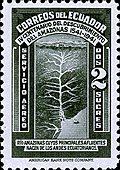| The Amazon: Has It Been Fully
Discovered? Raised Fields for Sustainable Agriculture in the Bolivian Amazon New Technology in the Ecuadorian Rainforest |
| The Amazon: Has It Been Fully
Discovered? Raised Fields for Sustainable Agriculture in the Bolivian Amazon New Technology in the Ecuadorian Rainforest |
People |
 |
|
| The
Amazon: Raised Fields For Sustainable Agriculture in the Bolivian Amazon |
||
| Until about 30 years ago, Western
academic opinion agreed that the Amazon Basin could never
have sustained large populations; due to the limitations
of a tropical environment, the area could support only
hunting and gathering and slash-and-burn agriculture.
Subsequent archaeological research proved this opinion
wrong. The savannas and forests of the Bolivian Amazon were, in fact, once densely populated by well-organized societies, and the landscape was heavily modified by pre-Columbian farmers. In the early 1960s, William Denevan and George Plafker uncovered evidence of massive earthworks in the savannas of the Llanos de Moxos, including raised fields, canals, causeways, reservoirs, dikes, and mound settlements. A joint project involving the Inter-American Foundation, the Parroquia of San Ignacio, the Bolivian Institute of Archaeology, and the University of Pennsylvania has developed an experimental program to put raised-field agriculture back into use. Shallow flood waters cover much of the low-lying lands in the Llano de Moxos during parts of the rainy season. The rest of the year, dry conditions prevail and water is scarce. The alternation between seasonal flooding and seasonal drought, combined with poor soil conditions and lack of drainage, makes farming these areas difficult. The ancient inhabitants of the area created an agricultural landscape to solve these problems and make the area highly productive.They constructed a system of raised fields, or large planting surfaces of earth elevated above the seasonally flooded savannas and wetlands. Experiments have shown that raised fields improve soil conditions and provide localized drainage and the means for water management, nutrient production, and organic recycling. Experiments in raised-field agriculture began in 1990 at the Biological Station of the Department of Beni in Bolivia. Because of its success, the project expanded into indigenous communities of the region. During 1993, the communities of Bermeo and Villa Esperanza decided to collaborate. They donated land, and the Inter-American Foundation provided funds to pay community members a small daily wage to build and maintain the fields. The raised fields have produced impressive harvests of manioc and maize. Community members carefully record data on each field to see whether these high levels can be sustained over a series of years. While initial construction costs of raised fields appear high, the high productivity which may be sustainable over a long period of continuous cropping makes raised-field farming a labor-efficient technology. Little maintenance is necessary to keep the fields in production. Many areas with similar conditions throughout lowland tropical Latin America could be farmed using raised-field technology. Highly productive raised-field farming could provide sustainable agricultural development for local communities and offer an alternative to cutting down the rainforest. |
||
[
The Amazon ]
[ Impacto, Influencia, Cambio ]
[ History of Science, Technology
and Invention ]